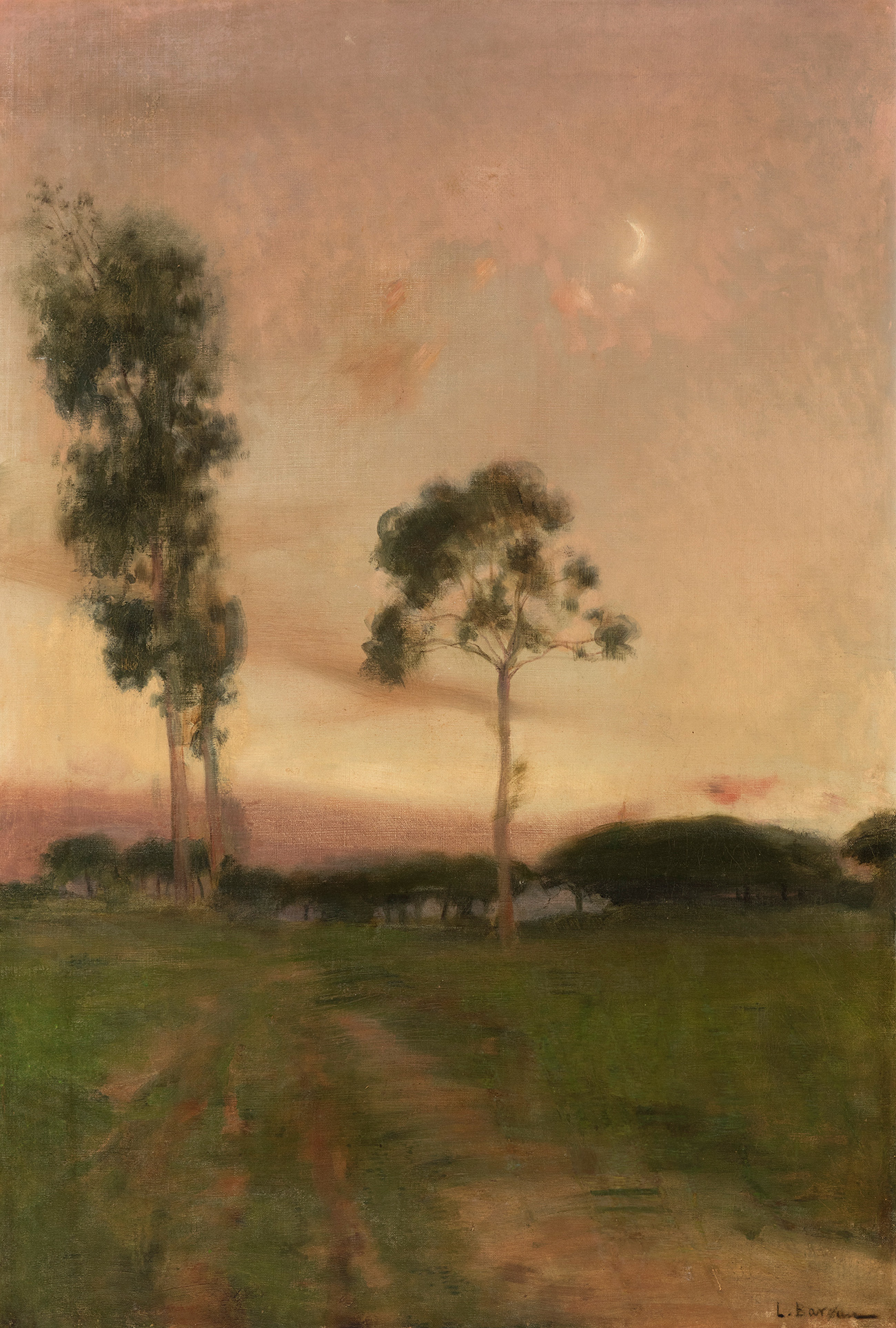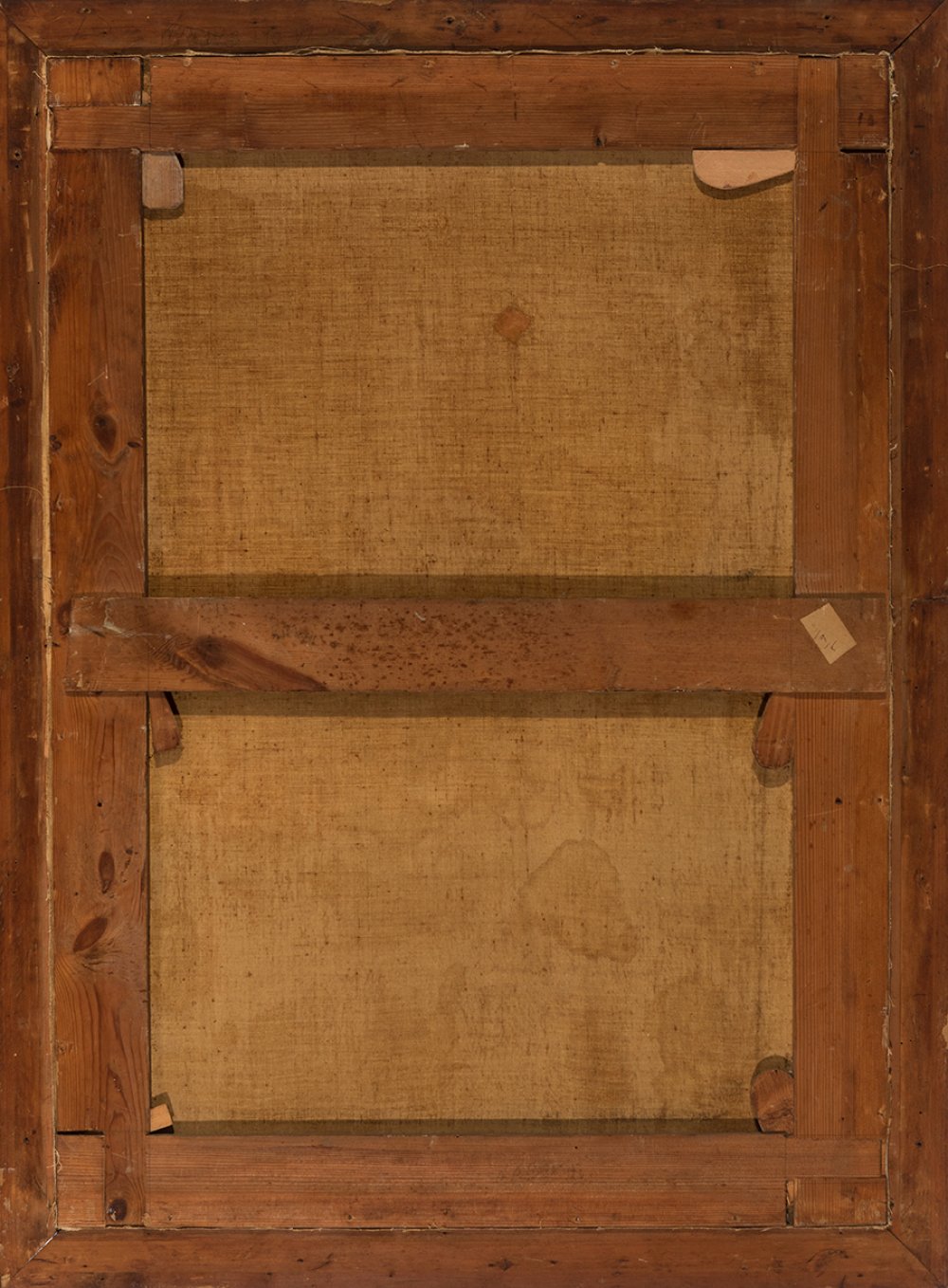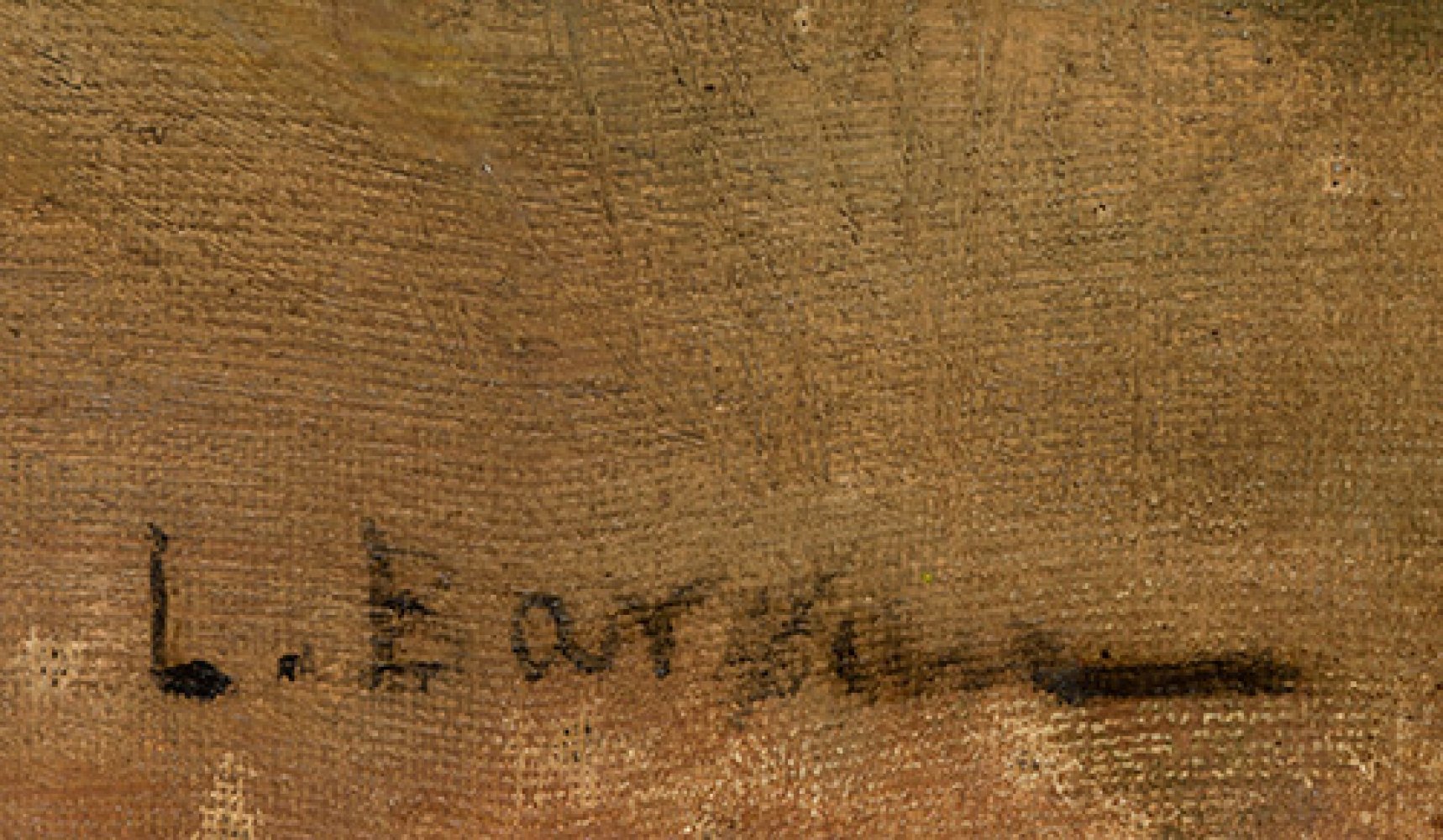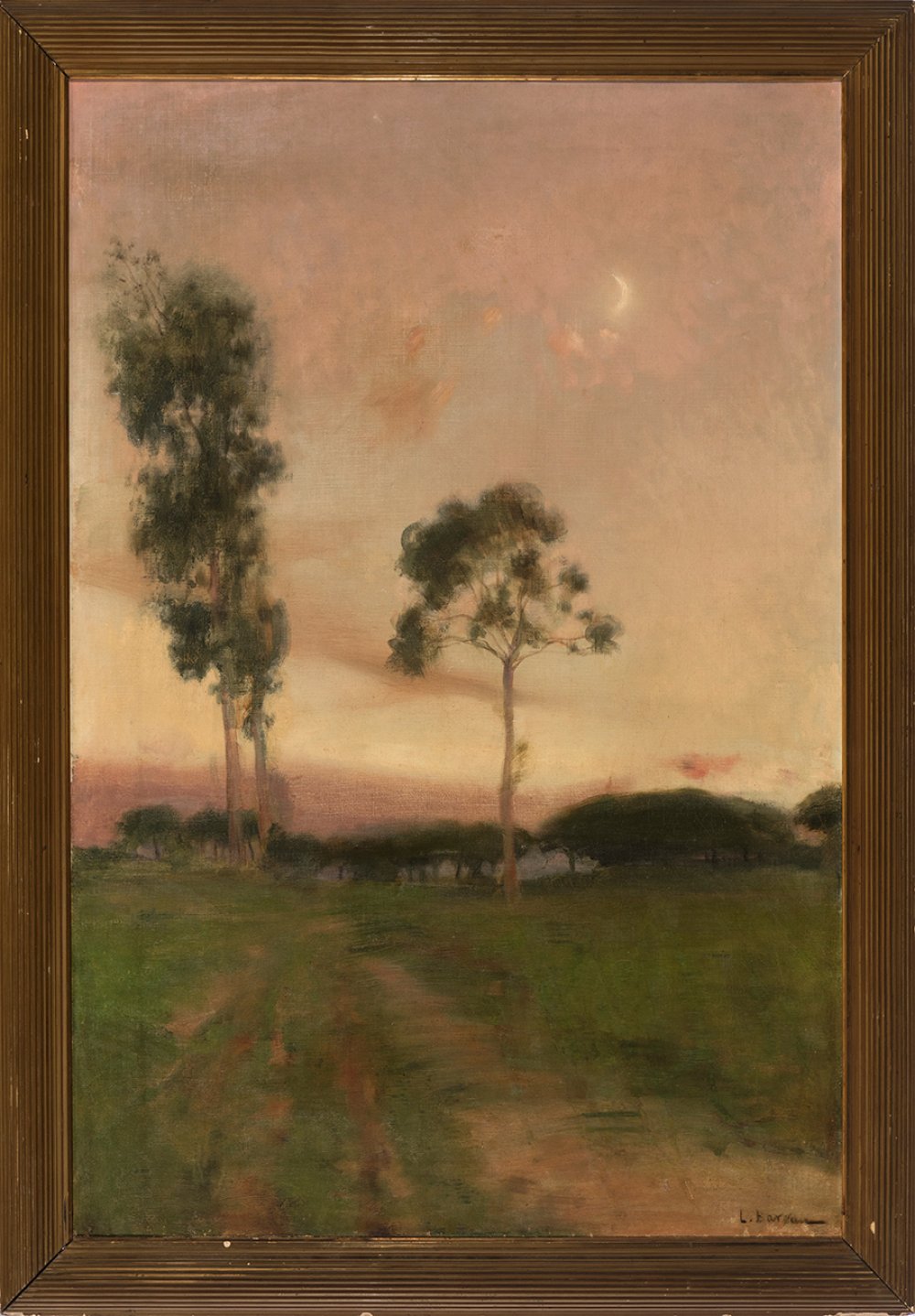54
LAUREANO BARRAU BUÑOL (Barcelona, 1864 - Santa Eulària des Riu, Ibiza, 1957)."Landscape".Oil on
1/4
Description
LAUREANO BARRAU BUÑOL (Barcelona, 1864 - Santa Eulària des Riu, Ibiza, 1957).
"Landscape".
Oil on canvas.
Signed in the lower right-hand corner.
It has a patch on the back.
Measurements: 90 x 63 cm; 100 x 73 cm (frame).
Laureano Barrau was born in the bosom of a bourgeois family, son of an industrial engineer and businessman. He began his training at the School of Fine Arts in Barcelona, where he was a pupil of Antonio Caba. Shortly afterwards he travelled to Madrid to broaden his training by studying the great masters of the Prado Museum. In 1884 the Barcelona City Council granted him the Fortuny Pension to extend his studies in Rome for three years. However, with the money from the travel grant Barrau moved to Paris, where he entered the Academy of Fine Arts, with Jean-Léon Gérôme as his tutor. In 1885, already in Rome, he studied the Italian masters and began to send to Barcelona the works that corresponded to him as a boarder. From 1887 he exhibited regularly at the Sala Parés in Barcelona, one of the most important Spanish galleries of the time, and the most prominent in Catalonia. That year his painting "The Surrender of Gerona" was a great success with critics and the public, as it represented a totally personal treatment of the genre of history painting, more vibrant and emotive. At the same time, Barrau frequently took part in official exhibitions both nationally and internationally. In 1888 he was awarded a second medal at the International Exhibition in Barcelona and a second prize at the Universal Exhibition in Brussels. Three years later, in 1891, he was awarded the title of member of the Salon de la Société Nationale des Beaux-Arts in Paris, and the following year he was awarded a third medal at the National Exhibition of Fine Arts in Madrid for his work "Escardadora". In 1904 he won a second medal at the same exhibition for "Taponeras del Ampurdán". Barrau also held numerous individual exhibitions and took part in group exhibitions in Paris, Barcelona, Madrid, New York and Rome. In 1909 he settled in Buenos Aires, where his work enjoyed the same success and recognition as it had in Spain and Europe, and after returning he settled permanently in Ibiza in 1911. From there he continued to show his work both in Spain and abroad, and in 1929 he was appointed "Societarie" of the Paris Salons. Barrau's work is based on an initial language linked to his neoclassical training, and evolves to reach a new concept characterised by luminosity and chromatic transparencies. To this day, the work he produced in Santa Eulària des Riu (Ibiza) at the end of his life is considered to be the best of his output. Laureano Barrau is currently represented in the Prado Museum, the Getty Museum in California, the Museums of Contemporary Art in Madrid and Barcelona, his house-museum in Santa Eulària des Riu and in various museums in Paris, Buenos Aires, Montevideo and Rio de Janeiro, as well as in important national and international private collections.
"Landscape".
Oil on canvas.
Signed in the lower right-hand corner.
It has a patch on the back.
Measurements: 90 x 63 cm; 100 x 73 cm (frame).
Laureano Barrau was born in the bosom of a bourgeois family, son of an industrial engineer and businessman. He began his training at the School of Fine Arts in Barcelona, where he was a pupil of Antonio Caba. Shortly afterwards he travelled to Madrid to broaden his training by studying the great masters of the Prado Museum. In 1884 the Barcelona City Council granted him the Fortuny Pension to extend his studies in Rome for three years. However, with the money from the travel grant Barrau moved to Paris, where he entered the Academy of Fine Arts, with Jean-Léon Gérôme as his tutor. In 1885, already in Rome, he studied the Italian masters and began to send to Barcelona the works that corresponded to him as a boarder. From 1887 he exhibited regularly at the Sala Parés in Barcelona, one of the most important Spanish galleries of the time, and the most prominent in Catalonia. That year his painting "The Surrender of Gerona" was a great success with critics and the public, as it represented a totally personal treatment of the genre of history painting, more vibrant and emotive. At the same time, Barrau frequently took part in official exhibitions both nationally and internationally. In 1888 he was awarded a second medal at the International Exhibition in Barcelona and a second prize at the Universal Exhibition in Brussels. Three years later, in 1891, he was awarded the title of member of the Salon de la Société Nationale des Beaux-Arts in Paris, and the following year he was awarded a third medal at the National Exhibition of Fine Arts in Madrid for his work "Escardadora". In 1904 he won a second medal at the same exhibition for "Taponeras del Ampurdán". Barrau also held numerous individual exhibitions and took part in group exhibitions in Paris, Barcelona, Madrid, New York and Rome. In 1909 he settled in Buenos Aires, where his work enjoyed the same success and recognition as it had in Spain and Europe, and after returning he settled permanently in Ibiza in 1911. From there he continued to show his work both in Spain and abroad, and in 1929 he was appointed "Societarie" of the Paris Salons. Barrau's work is based on an initial language linked to his neoclassical training, and evolves to reach a new concept characterised by luminosity and chromatic transparencies. To this day, the work he produced in Santa Eulària des Riu (Ibiza) at the end of his life is considered to be the best of his output. Laureano Barrau is currently represented in the Prado Museum, the Getty Museum in California, the Museums of Contemporary Art in Madrid and Barcelona, his house-museum in Santa Eulària des Riu and in various museums in Paris, Buenos Aires, Montevideo and Rio de Janeiro, as well as in important national and international private collections.
Auction Details
Shipping
T&Cs & Important Info
Ask seller a question
LAUREANO BARRAU BUÑOL (Barcelona, 1864 - Santa Eulària des Riu, Ibiza, 1957).
"Landscape".
Oil on canvas.
Signed in the lower right-hand corner.
It has a patch on the back.
Measurements: 90 x 63 cm; 100 x 73 cm (frame).
Laureano Barrau was born in the bosom of a bourgeois family, son of an industrial engineer and businessman. He began his training at the School of Fine Arts in Barcelona, where he was a pupil of Antonio Caba. Shortly afterwards he travelled to Madrid to broaden his training by studying the great masters of the Prado Museum. In 1884 the Barcelona City Council granted him the Fortuny Pension to extend his studies in Rome for three years. However, with the money from the travel grant Barrau moved to Paris, where he entered the Academy of Fine Arts, with Jean-Léon Gérôme as his tutor. In 1885, already in Rome, he studied the Italian masters and began to send to Barcelona the works that corresponded to him as a boarder. From 1887 he exhibited regularly at the Sala Parés in Barcelona, one of the most important Spanish galleries of the time, and the most prominent in Catalonia. That year his painting "The Surrender of Gerona" was a great success with critics and the public, as it represented a totally personal treatment of the genre of history painting, more vibrant and emotive. At the same time, Barrau frequently took part in official exhibitions both nationally and internationally. In 1888 he was awarded a second medal at the International Exhibition in Barcelona and a second prize at the Universal Exhibition in Brussels. Three years later, in 1891, he was awarded the title of member of the Salon de la Société Nationale des Beaux-Arts in Paris, and the following year he was awarded a third medal at the National Exhibition of Fine Arts in Madrid for his work "Escardadora". In 1904 he won a second medal at the same exhibition for "Taponeras del Ampurdán". Barrau also held numerous individual exhibitions and took part in group exhibitions in Paris, Barcelona, Madrid, New York and Rome. In 1909 he settled in Buenos Aires, where his work enjoyed the same success and recognition as it had in Spain and Europe, and after returning he settled permanently in Ibiza in 1911. From there he continued to show his work both in Spain and abroad, and in 1929 he was appointed "Societarie" of the Paris Salons. Barrau's work is based on an initial language linked to his neoclassical training, and evolves to reach a new concept characterised by luminosity and chromatic transparencies. To this day, the work he produced in Santa Eulària des Riu (Ibiza) at the end of his life is considered to be the best of his output. Laureano Barrau is currently represented in the Prado Museum, the Getty Museum in California, the Museums of Contemporary Art in Madrid and Barcelona, his house-museum in Santa Eulària des Riu and in various museums in Paris, Buenos Aires, Montevideo and Rio de Janeiro, as well as in important national and international private collections.
"Landscape".
Oil on canvas.
Signed in the lower right-hand corner.
It has a patch on the back.
Measurements: 90 x 63 cm; 100 x 73 cm (frame).
Laureano Barrau was born in the bosom of a bourgeois family, son of an industrial engineer and businessman. He began his training at the School of Fine Arts in Barcelona, where he was a pupil of Antonio Caba. Shortly afterwards he travelled to Madrid to broaden his training by studying the great masters of the Prado Museum. In 1884 the Barcelona City Council granted him the Fortuny Pension to extend his studies in Rome for three years. However, with the money from the travel grant Barrau moved to Paris, where he entered the Academy of Fine Arts, with Jean-Léon Gérôme as his tutor. In 1885, already in Rome, he studied the Italian masters and began to send to Barcelona the works that corresponded to him as a boarder. From 1887 he exhibited regularly at the Sala Parés in Barcelona, one of the most important Spanish galleries of the time, and the most prominent in Catalonia. That year his painting "The Surrender of Gerona" was a great success with critics and the public, as it represented a totally personal treatment of the genre of history painting, more vibrant and emotive. At the same time, Barrau frequently took part in official exhibitions both nationally and internationally. In 1888 he was awarded a second medal at the International Exhibition in Barcelona and a second prize at the Universal Exhibition in Brussels. Three years later, in 1891, he was awarded the title of member of the Salon de la Société Nationale des Beaux-Arts in Paris, and the following year he was awarded a third medal at the National Exhibition of Fine Arts in Madrid for his work "Escardadora". In 1904 he won a second medal at the same exhibition for "Taponeras del Ampurdán". Barrau also held numerous individual exhibitions and took part in group exhibitions in Paris, Barcelona, Madrid, New York and Rome. In 1909 he settled in Buenos Aires, where his work enjoyed the same success and recognition as it had in Spain and Europe, and after returning he settled permanently in Ibiza in 1911. From there he continued to show his work both in Spain and abroad, and in 1929 he was appointed "Societarie" of the Paris Salons. Barrau's work is based on an initial language linked to his neoclassical training, and evolves to reach a new concept characterised by luminosity and chromatic transparencies. To this day, the work he produced in Santa Eulària des Riu (Ibiza) at the end of his life is considered to be the best of his output. Laureano Barrau is currently represented in the Prado Museum, the Getty Museum in California, the Museums of Contemporary Art in Madrid and Barcelona, his house-museum in Santa Eulària des Riu and in various museums in Paris, Buenos Aires, Montevideo and Rio de Janeiro, as well as in important national and international private collections.
31st August -19th & 20th Century Arts
Sale Date(s)
Venue Address
Aragón 346, Barcelona
Calle Velázquez 7, Madrid
Carrer de Cirilo Amorós 55, Valencia
Barcelona
08009
Spain
General delivery information available from the auctioneer
Setdart offers Worldwide shipping
PICK UP IN ROOM: You can come and pick up your lots in our offices (Barcelona, Madrid or Valencia). At the moment of the withdrawal, you will be able to accept the current conditions of the lot by means of a document that you will sign.
YOU CAN SEND ANOTHER PERSON TO PICK UP: This person must present a signed authorization that you can find in our web page by accessing from BUY AT SETDART- LOGISTICS-DOWNLOAD AUTHORIZATION DOCUMENT. You can also send an e-mail with the requested data in AUTHORIZATION DOCUMENT to admin@setdart.com
Important Information
25% buyer´s premium
21% buyer´s premium at www.setdart.com












